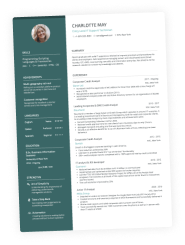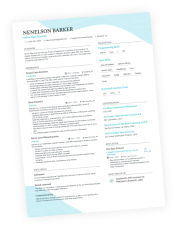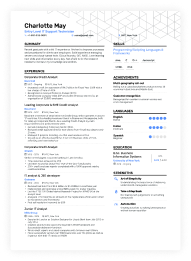In a sea of job applications, numbers are your lifeline to standing out. They offer a clear, objective way to demonstrate your impact. Numbers validate your experience by providing measurable evidence of your contributions.
Saying you've "improved sales" is one thing. Saying you’ve "increased sales by 20% in one year" is another. Metrics like these make your resume easier to scan and more convincing, especially when hiring managers need to assess your value quickly.
This approach works across industries. Whether you're in marketing, finance, HR, or customer service, numbers tell a story of results and reliability. They convert your responsibilities into accomplishments.
Key takeaways
- Numbers on a resume validate your achievements with measurable results.
- Metrics such as revenue growth, cost savings, and satisfaction scores are powerful.
- Even soft skills like leadership or communication can be quantified.
- Real examples include increasing retention, boosting campaign ROI, and cutting delivery timelines.
- Use the STAR method and performance data to identify and format key metrics.
Is your resume good enough?
Drop your resume here or choose a file. PDF & DOCX only. Max 2MB file size.
Where and how to showcase your numbers
Knowing which numbers to include is only half the strategy—where you include them significantly affects how impactful they are. Strategic placement boosts resume clarity, enhances scannability, and helps both human reviewers and applicant tracking systems (ATS) connect your value to the job at hand.
Below is a breakdown of the most effective locations for your metrics and how to optimize them.
1. Work history section
Why it works:
This is the most expected and natural location for metrics. Recruiters often scan work experience first to assess real-world impact. Each bullet point is an opportunity to turn passive responsibilities into results-driven stories.
How to do it:
- Begin with strong action verbs (e.g., improved, launched, scaled).
- Include at least one metric per role—two or three for some senior roles, such as project manager, team leader, etc.
- Focus on quantifying achievements, not just tasks.
- Prioritize recent roles with the strongest outcomes.
Best-practice format:
Action + task + metric + timeframe or benchmark
- •Reduced onboarding time by 30% by overhauling and standardizing training documentation, enabling new hires to reach productivity benchmarks two weeks faster on average.
- •Achieved 99.5% system uptime, surpassing the contractual SLA by 0.5% and contributing to a 12% decrease in client escalations year over year.
- •Increased email open rates by 18% in Q3 through segmented subject line A/B testing, improving internal communications and stakeholder engagement across departments.
Be bold
Use boldface to emphasize key numbers or results (if your resume format allows it), helping hiring managers spot value quickly.
2. Resume summary or profile section
Why it works:
The resume summary or objective appears at the top of your resume, making it a prime location for high-impact metrics. Think of it as your headline pitch—why you’re the best fit in one snapshot.
How to do it:
- Keep it concise: three to four lines or bullet points max (see the example below).
- Include one or two quantifiable highlights that reflect your core strengths.
- Focus on career-defining metrics (e.g., revenue generated, clients served, efficiencies gained).
Best-practice format:
Adjective + role + quantified achievement + industry or specialty
Resume summary
A brief overview of your professional background, key achievements, and skills tailored to the job you're applying for.
Best for experienced professionals, career changers, or anyone with a solid work history looking to highlight qualifications and achievements relevant to the target role.
Use bullets if:
- You're creating a performance summary or key accomplishments box at the top of your resume.
- You want to improve scannability for ATS or busy recruiters.
- You're in a field where quantifiable outcomes matter (e.g., sales, tech, operations).
- You're using a modern resume format with sections like “Professional Highlights” or “Snapshot.”
Resume summary with bullet points
Professional Summary
- Operations Manager with 8+ years of experience streamlining logistics and reducing costs.
- Achieved $200K in annual savings through supply chain optimization.
- Proven leader of cross-functional teams with 95% project delivery rate.
Resume objective
A short statement outlining your career goals and what you aim to contribute to the company or role.
Best for entry-level candidates, recent graduates, career changers, or individuals making a significant career shift who want to emphasize goals, motivation, or transferable skills.
PRO TIP
If you're applying for a competitive role, consider beginning your resume profile with your most impressive stat (e.g., “$2M in revenue growth generated…”).
3. Skills section (when paired with metrics)
Why it works:
The skills section is often overlooked as a strategic opportunity to reinforce your value with data. By pairing skills—whether soft, technical, or transferable—with measurable outcomes, you make each skill more tangible, credible, and memorable.
PRO TIP
The functional resume format emphasizes skills over job titles, making it ideal for highlighting core competencies when changing careers, addressing employment gaps, or applying to roles where transferable abilities matter more than linear experience.
Soft skills
Soft skills include personal attributes like leadership, communication, and emotional intelligence. While hard to measure directly, you can demonstrate their impact through team results, culture change, or interpersonal outcomes.
How to quantify soft skills:
- Link to outcomes involving people, processes, or problem resolution.
- Use productivity, retention, feedback scores, or conflict resolution as proof.
PRO TIP
Don’t say you're a “strong leader”—show how your leadership improved performance or morale.
Hard / Technical skills
Hard skills (or technical) include systems, tools, programming languages, and domain-specific abilities (e.g., Excel modeling, Python, CRM platforms).
How to quantify technical skills:
- Tie each tool or method to performance gains, speed improvements, or error reduction.
- Highlight certifications only when paired with real-world application or results.
PRO TIP
For highly technical roles, list relevant tools in a standalone section, but still embed at least one metric-rich bullet per key tool.
Transferable skills
These are broad competencies that apply across industries or job functions—skills like project management, problem-solving, adaptability, or time management.
How to quantify transferable skills:
- Emphasize repeatable success across roles or industries.
- Use before-and-after scenarios, efficiency metrics, or output improvements.
PRO TIP
Use transferable skills to help bridge industries during a career change or to supplement gaps in technical depth.
Formatting tip:
If your resume layout allows, use a table, columns, or bullet clusters to group skills by type.
Here's a basic format:
Skills
- Soft: Leadership (reduced turnover by 20%) | Communication (improved alignment by 30%)
- Technical: Excel (increased forecast accuracy by 18%) | HubSpot (boosted MQLs by 22%)
- Transferable: Time Management (cut backlog by 35%) | Cross-functional Collaboration (enhanced delivery speed by 15%)
This approach enhances both readability and impact, making your skills section more than just a keyword list.
PRO TIP
Hiring managers aren’t looking for buzzwords—they’re looking for proof. Every time you claim a strength, pair it with a number that shows what that strength delivered.
4. Projects or highlights sections
Why it works:
Ideal for job seekers who operate on a project basis, such as freelancers, creatives, developers, or those making a career pivot. Projects on your resume often reflect current skills and innovation more clearly than legacy job titles.
How to do it:
- Choose two to four standout projects with clearly defined outcomes.
- Include project name, role, and quantifiable results.
- Prioritize relevance to the job you’re applying for.
Best-practice format:
Project + goal + result + tools/approach (optional)
PRO TIP
Use this section to showcase accomplishments that might not neatly fit under a job title—especially if you're early in your career or transitioning between fields.
5. Cover letters and LinkedIn profiles
Why it works:
Your resume isn’t the only place where numbers count. Including consistent metrics across your professional documents, like your cover letter and LinkedIn profile, reinforces your value and makes your brand memorable.
Cover letters
How to do it:
- Choose one or two key metrics that directly relate to the job description.
- Highlight a problem-solution-result story in paragraph form.
- Use metrics to back up your claims of experience and fit.
Jordan Ellis
Marketing Operations Specialist
Denver, CO | (555) 321-7782 | jordan.ellis@email.com | linkedin.com/in/yourname
Dear Hiring Manager,
I’m thrilled to apply for the Marketing Operations Specialist role at Lumenlytics. Your commitment to building data-backed marketing systems speaks to the core of what I do best—simplifying complex workflows, improving data quality, and enabling faster, smarter campaign execution.
At CypherMark, our onboarding process was broken. New hires took an average of 10 days to get up to speed, causing delays across our launch timelines. I led the full redesign of our training experience—rewrote SOPs, introduced automated walkthroughs, and centralized knowledge sharing. We cut onboarding time from 10 days to just 4, and campaign launch speed increased by 28%.
I also tackled a CRM audit project that had been deprioritized for months. With marketing attribution suffering and lead routing falling short, I stepped in. By eliminating 80% of duplicate records and tightening up our lead rules, we boosted routing accuracy and saw a 22% lift in MQL conversions. Clean data isn’t glamorous—but it works.
I love working behind the scenes to make marketing run like a machine. Lumenlytics feels like the kind of place where precision and initiative are valued, and I’d love the chance to bring both to your team.
Looking forward to hearing from you,
Jordan Ellis
How to do it:
- Use your headline and summary section on LinkedIn to showcase major wins.
- Include performance metrics in your experience section, just like on your resume.
- Add media or portfolio links that visually reinforce your impact (e.g., charts, decks, project links).
LinkedIn headline example:
“Cross-functional product lead with a track record of launching 6+ SaaS tools and shortening time-to-market by up to 35%.”
PRO TIP
Don’t overlook consistency. If a recruiter sees “boosted retention by 25%” on your resume but “helped improve retention” on LinkedIn, it can raise flags. Align numbers across all touchpoints.
Turn your LinkedIn profile into a results-driven resume—build yours now with Enhancv’s LinkedIn Resume Builder.
Final thought on placement
Your resume’s visual structure should allow the most compelling numbers to pop. Whether you're using a minimalist design or a more modern template, consider using bolded text, section headers, or short bullets to help your metrics guide the reader’s eye.
Rule of thumb: If a hiring manager only skims your resume for mere seconds, will they catch your most valuable metric? If not, it may be in the wrong place.
Tips and tools for adding impactful resume metrics
Including metrics on your resume isn’t just about adding numbers—it’s about using them strategically.
To make your data work harder and stand out to both applicant tracking systems and human reviewers, use the following best practices and tools:
Use the STAR method to frame achievements
Structure your bullet points using the STAR formula:
- Situation
- Task
- Action
- Result
The key is to focus on the result, ensuring it's measurable.
Instead of: “Led the marketing team to improve campaigns.”
Try: “Led a 6-person marketing team that improved campaign ROI by 45% in Q2.”
Make strategic comparisons
Give hiring managers context by adding benchmarks:
- “Reduced churn by 10%, outperforming the company average of 5%.”
- “Improved ticket resolution time by 40%—twice the departmental goal.”
This makes your impact more meaningful by showing it’s not just change—it’s improvement against a standard.
Tailor your metrics to the job
Not all numbers are equally impressive for every role. Choose those most relevant to the job description. If the role focuses on operations, emphasize time savings or process improvements. If it’s a sales position, prioritize revenue, quota attainment, or client acquisition metrics.
Be honest and conservative with estimates
If exact figures aren’t available, use ranges or approximations.
Stick to:
- “Managed a budget of approximately $250K.”
- “Improved process efficiency by an estimated 15–20%.”
Being transparent builds credibility. Inflated or unverifiable claims can damage your candidacy.
Keep it readable and consistent
- Use numerals (e.g., 12% rather than “twelve percent”) to improve scannability.
- Use consistent formatting for currency and percentages (e.g., $500K, not “500,000 dollars”).
- Round numbers for simplicity (e.g., “over 100 clients served,” instead of “102”).
Use AI and resume-building tools
Don’t rely on memory alone—use digital tools to help you surface and showcase your impact:
- Resume builders (like Enhancv): Offer pre-structured templates that prompt metric-driven writing.
- ATS scanners: Identify weak areas and keyword gaps, helping you align with job descriptions.
- Google Docs: Use version history and comments to track revisions and collaborate with peers or coaches.
- AI tools: Can analyze your experience and suggest where quantifiable accomplishments might be hiding.
Most resumes read like job descriptions. That’s a missed opportunity. Numbers don’t just show what you did—they prove it mattered. Even a rough estimate is better than none. If you’re not quantifying your impact, you’re expecting the hiring manager to do the math for you—and they won’t.
Writer’s take
Score and analyze before you submit
Use tools that provide an overall “resume score” or impact analysis. These platforms flag vague language and recommend clearer, more metric-focused alternatives.
PRO TIP
It's most likely not the design that gets you the interview—it's the data. A clean, keyword-optimized resume packed with measurable outcomes always beats a flashy one with fluff.
Methods for identifying and gathering metrics
If you’re drawing a blank on which numbers to use, you’re not alone.
Here are practical ways to identify the metrics you already have access to:
Track your work
Maintain a log of completed projects, KPIs met, or outcomes improved. Even daily or weekly goals can reveal useful stats.
Reflect on performance data
Leverage:
- Sales dashboards
- CRM tools
- Performance reviews
- Weekly stand-up summaries
- Annual reports
Compile data from team outcomes
Even if you're not the team lead, your contribution counts.
- "Helped increase visitor traffic by 35% quarter-over-quarter."
- "Supported event that drew 3,000+ attendees with 92% positive feedback."
Estimate and make use of ranges
Use conservative estimates when precise data isn't available.
- "Managed approximately $250K in annual budgets."
- "Collaborated on 15+ marketing campaigns in 12 months."
Review job descriptions
Use them to reverse engineer which metrics matter most to hiring managers. If a listing says "experience increasing engagement," tailor your metric to show that.
Applicant tracking systems
Most large companies use ATS to organize—not reject—resumes. Modern ATS software can handle columns, colors, and even two-page resumes. What matters is clear formatting and keyword alignment with the job post so both humans and systems can scan your resume effectively.
Common metrics to showcase in your resume
Not all numbers are created equal. The most effective metrics are those that align with your role and showcase your direct impact.
Here are the key categories to consider:
1. Sales & revenue
If your efforts have driven sales, profit margins, or customer acquisition, state the exact figures. These metrics provide instant credibility.
- "Generated $500K in new revenue within six months by launching an outreach strategy."
- "Increased upsell conversions by 30% through targeted email campaigns."
- "Closed 45 new client deals in Q1, achieving 120% of quarterly quota."
- "Improved average deal size by 18% by introducing bundled offerings."
2. Cost savings & efficiency
Cost control and process optimization are highly prized across roles.
- "Cut operational costs by 15% by automating manual workflows."
- "Reduced production errors by 25% through implementation of weekly quality audits."
- "Saved $150K annually by renegotiating supplier contracts."
- "Increased operational throughput by 35% without additional headcount."
3. Team leadership & collaboration
Your ability to manage, mentor, and work in teams is key, especially for senior roles.
- "Managed a team of 12; improved departmental output by 20%."
- "Led a cross-functional task force that completed a system migration 10% under budget."
- "Reduced onboarding time by 50% by creating a peer mentorship initiative."
- "Developed an intern-to-hire pipeline, resulting in 3 full-time conversions in one year."
4. Project success & timelines
Project-based roles benefit from timeline-based accomplishments.
- "Completed CRM transition three months ahead of schedule."
- "Delivered 100% of projects on time and within budget for two consecutive years."
- "Launched a new product line in 7 months, beating the expected 12-month timeline."
- "Coordinated 6 product releases across 4 regions, ensuring delivery synchronization."
5. Customer satisfaction & retention
Show your value in customer-facing roles with metrics that reflect satisfaction and loyalty.
- "Raised customer satisfaction scores by 25% within a year."
- "Improved customer retention by 30% through redesigning loyalty rewards program."
- "Handled 1,200+ support tickets monthly with a 97% resolution satisfaction rate."
- "Achieved a 95% first-call resolution rate, reducing repeat inquiries."
6. Marketing & engagement
Digital engagement metrics signal performance and creativity.
- "Grew newsletter subscriber base by 40% in six months."
- "Improved click-through rate by 12% with multivariate A/B testing."
- "Increased social media engagement by 60% through influencer partnerships."
- "Reduced cost per acquisition by 25% through audience segmentation."
7. Training & development
Numbers here can validate your effectiveness in upskilling others.
- "Reduced onboarding time by 50% with a redesigned training manual."
- "Increased post-training assessment scores by 25% through new e-learning modules."
- "Delivered 10 workshops attended by over 200 staff across departments."
- "Created a certification track resulting in 30% more employees passing external exams."
8. Operational improvements
Small changes that lead to big improvements are easy wins.
- "Implemented safety protocol that reduced workplace incidents by 70%."
- "Consolidated three legacy systems into one, cutting data retrieval time by 40%."
- "Automated invoice processing, reducing cycle time from 10 to 3 days."
- "Reduced downtime by 50% through proactive equipment maintenance schedules."
PRO TIP
Metrics don’t have to be dramatic to be effective. Even moderate improvements—like a 10% increase in efficiency—can make your resume feel more credible and persuasive.
Industry-specific and role-specific examples
Metrics become even more powerful when tailored to your specific field.
Here's how to think industry-first:
Sales & business development
- "Ranked #2 of 40 in regional sales volume."
- "Exceeded quarterly quota by 35% for five consecutive periods."
- "Added $1.2M in new pipeline opportunities in 2024."
Marketing
- "Increased lead generation by 60% through targeted landing pages."
- "Boosted organic traffic 80% using SEO optimization strategies."
- "Cut ad spend waste by 20% through ROI tracking."
IT & development
- "Improved system uptime from 96% to 99.9% in under 6 months."
- "Reduced bug tickets by 40% via test automation."
- "Migrated 100K+ records to cloud with zero downtime."
Education & training
- "Raised standardized testing scores by an average of 18%."
- "Implemented curriculum updates that increased student engagement by 25%."
- "Trained over 150 educators in virtual classroom software."
Human resources
- "Cut payroll errors by 50% through system migration."
- "Increased company morale scores by 22% through а new onboarding process."
- "Decreased average time-to-hire from 45 to 21 days."
Customer service
- "Maintained 98% customer satisfaction across 300+ monthly tickets."
- "Reduced average resolution time from 48 to 16 hours."
- "Handled 150% ticket volume increase during product launch without SLA breaches."
PRO TIP
Recruiters care more about outcomes than effort. Focus on impact analysis over vague responsibilities. If you improved rankings, cut costs, or resolved conflicts effectively, highlight it—don’t bury it!
Conclusion
Numbers transform your resume from a list of duties to a story of achievements. Recruiters want proof, and metrics provide it. From boosting revenue to improving retention, using data shows you can deliver value in any role.
Take the time to dig into your accomplishments and surface those quantifiable wins. Then use formatting best practices—like strategic resume bullet points, concise resume summaries, and an optimized resume layout—to bring them to life.
Done right, your resume will stand out not only for what you did, but for what you achieved.
Make one that's truly you.



